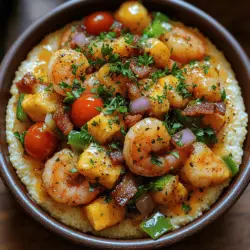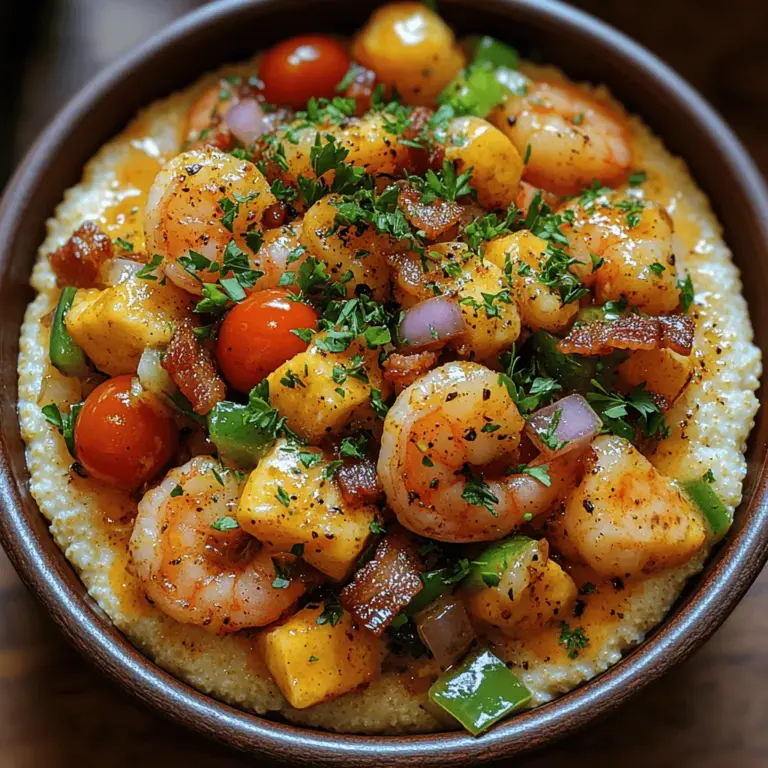Introduction
Southern cuisine is more than just a collection of recipes; it is a vibrant tapestry woven from the rich history and cultural influences of the American South. This culinary tradition reflects the region’s diverse heritage, where Native American, African, and European influences converge to create unique flavors and comforting dishes that tell a story. Among these beloved recipes, few are as iconic and cherished as Shrimp and Grits.
Originating from the coastal regions of the South, shrimp and grits has evolved from a humble breakfast dish into a celebrated entrée that graces tables across the country. Its combination of succulent shrimp, creamy grits, and a medley of flavors makes it a quintessential comfort food that resonates with both locals and visitors alike. The beauty of shrimp and grits lies not only in its taste but also in its ability to bring people together, making it a must-try dish for anyone looking to explore the depths of Southern culinary culture.
In this article, we will delve into the Ultimate Southern Shrimp and Grits, providing you with a detailed recipe and insights into the preparation and significance of each ingredient. Whether you’re a seasoned cook or a novice in the kitchen, this guide will equip you with everything you need to create this mouthwatering dish that will surely impress your family and friends.
Understanding the Ingredients
To achieve the ultimate shrimp and grits experience, it’s essential to understand the key components that make this dish shine. Each ingredient plays a crucial role in delivering the rich, savory flavors that characterize this Southern classic.
Stone-Ground Grits
At the heart of shrimp and grits lies the grits themselves, and using stone-ground grits is imperative for an authentic Southern flavor. Unlike instant grits, which can lack texture and flavor, stone-ground grits are made by milling whole corn kernels, resulting in a coarser texture and a more robust corn flavor. They take longer to cook, but the creamy, buttery texture they yield is well worth the wait. This fundamental ingredient not only serves as a base for the dish but also offers a satisfying mouthfeel that complements the shrimp beautifully.
Fresh Shrimp
Shrimp is the star of this dish, and using fresh, high-quality shrimp is non-negotiable. The flavor and texture of fresh shrimp far surpass that of frozen varieties, making a significant impact on the overall taste of your dish. When choosing shrimp, look for those that are firm, translucent, and have a mild ocean scent. Additionally, opting for wild-caught shrimp over farmed varieties can enhance the flavor profile, as they tend to be more flavorful and sustainable.
Bacon
Adding a touch of bacon not only introduces a delightful smokiness but also enhances the overall flavor of the dish. The rendered bacon fat serves as a flavorful base for cooking the shrimp, while the crispy bits add a satisfying crunch. This ingredient embodies the essence of Southern cooking—using every part of an ingredient to maximize flavor and texture.
Flavor Components
The magic of shrimp and grits comes from the harmonious blend of various seasonings. A combination of Cajun seasoning, smoked paprika, and Worcestershire sauce elevates the dish and adds depth to the flavor profile. Cajun seasoning, with its spicy and aromatic blend of spices, brings warmth and richness, while smoked paprika adds a subtle smokiness that complements the shrimp. Worcestershire sauce contributes a tangy umami flavor that ties all the elements together.
Cream and Cheese
To achieve that signature creamy texture that shrimp and grits are known for, incorporating heavy cream and cheddar cheese is essential. Heavy cream adds richness and a velvety mouthfeel to the grits, while the addition of sharp cheddar cheese introduces a delightful tanginess. These elements meld together beautifully, resulting in a luscious base that perfectly balances the savory shrimp and spices.
Preparation of the Grits
Cooking the grits may seem straightforward, but achieving the perfect texture requires attention to detail and a few essential techniques. Here’s a step-by-step guide to preparing stone-ground grits that will serve as the foundation for your shrimp and grits.
Step 1: Boil Water and Incorporate Salt
Begin by bringing a large pot of water to a rolling boil. The general ratio for cooking grits is four parts water to one part grits, so adjust accordingly based on the amount you’re preparing. Once the water reaches a boil, add a generous pinch of salt. This step is crucial, as it helps season the grits from the very beginning.
Step 2: Whisk in the Grits
With the water boiling, it’s time to add the stone-ground grits. To prevent lumps from forming, slowly whisk the grits into the boiling water. This technique ensures that each grain is evenly distributed and helps avoid clumping. Whisk continuously for the first minute to give the grits a head start on cooking.
Step 3: Reduce Heat and Simmer
Once the grits are fully incorporated into the water, reduce the heat to low, cover the pot, and allow the mixture to simmer. Stir the grits occasionally to prevent them from sticking to the bottom of the pot. Depending on the brand and type of grits, cooking time can vary but typically ranges from 25 to 40 minutes.
Step 4: Check for Doneness
You’ll know the grits are ready when they are creamy and have absorbed most of the liquid. They should be tender with a slight bite, similar to al dente pasta. If the grits are too thick, you can add a splash of water or broth to achieve your desired consistency.
Step 5: Enhance with Cream, Butter, and Cheese
Once the grits are cooked to perfection, it’s time to elevate them further. Stir in a generous amount of heavy cream, a dollop of butter, and a handful of freshly grated cheddar cheese. The heavy cream adds richness, the butter enhances the flavor, and the cheese provides that unmistakable creamy goodness. Mix well until all ingredients are fully incorporated, and taste for seasoning, adjusting as necessary.
Step 6: Final Seasoning
Before serving, give the grits a final taste test. Depending on your preference, you may want to adjust the seasoning with additional salt, pepper, or even a dash of hot sauce for an extra kick. The goal is to ensure that the grits are not only flavorful on their own but also complement the shrimp and other elements of the dish.
In the next section, we will dive into the process of cooking the shrimp, ensuring that they are perfectly seasoned and cooked to enhance the overall dish. Stay tuned for the delicious finale of this Southern classic!



